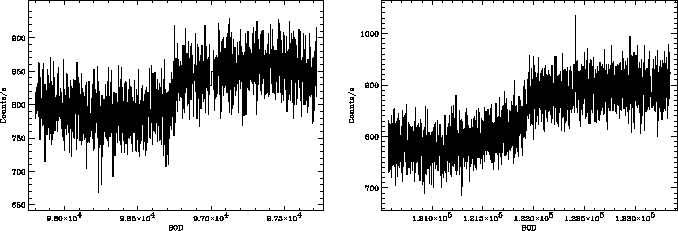



Next: The Early SWTCs
Up: Medium and Short Time
Previous: pre-SAGA Events
Contents
Crab and CygX-1 Occultation Steps
Finally, there are several known X-ray sources which can be
detected within the GRBM band ratemeters: the two brightest
ones are the Crab Nebula and the black hole candidate CygX-1.
Because of their directions in the sky, these sources are
periodically hidden by the Earth, while BeppoSAX moves along
its orbit: this gives rise to periodic occultations,
like those shown in fig. ![[*]](crossref.png) ).
).
Figure:
Two single occultation steps in the GRBM band, unit 1: left panel:
Crab (
 ,
, 
 , OP 03991); right panel:
CygX-1 (
, OP 03991); right panel:
CygX-1 (
 ,
, 
 , OP 04421).
, OP 04421).
 |
Moreover, like in the case of BATSE ([Zhang et al., 1993,Zhang et al., 1994,Zhang et al., 1995]), [Guidorzi et al., 1998] ,
exploited the Earth occultation technique to monitor such
bright sources by means of the GRBM ratemeters:
in particular, in order to reduce the statistical noise,
several contiguous occultations are summed together, as long as the
satellite attitude does not change (usually, 10-15 occultations
are summed together); then, an occultation
profile, based on a model of the terrestrial atmosphere, is fitted
to the summed data, thus providing an estimate of the source mean rate.
Figure:
Summed occultation steps of Crab in the GRBM band, unit 1:
left panel: occ. beginning; right panel: occ. end (OP 03991).
 |
Figure:
Summed occultation steps of CygX-1 in the GRBM band, unit 1:
left panel: occ. beginning; right panel: occ. end (OP 04421, May 1998).
 |
This technique made it possible to test the GRBM on-ground calibrations
by monitoring the Crab Nebula at different angles with respect
to the GRBM detector units; besides, it allowed to monitor variable
sources as bright as CygX-1 ([Guidorzi et al., 1998]).
In particular, the mean rate due to Crab (figg. ![[*]](crossref.png) ),
when the source is on axis to the units 1 or 3 (those with the better
sensitivity), is
),
when the source is on axis to the units 1 or 3 (those with the better
sensitivity), is  counts/s in the GRBM band
and
counts/s in the GRBM band
and  in the AC band, while the
mean rate from CygX-1 (figg.
in the AC band, while the
mean rate from CygX-1 (figg. ![[*]](crossref.png) ),
variable on timescales from days to months,
ranges from 5 to 40 c/s in the GRBM band and from 0 to 20 in the
AC band.
While in figg.
),
variable on timescales from days to months,
ranges from 5 to 40 c/s in the GRBM band and from 0 to 20 in the
AC band.
While in figg. ![[*]](crossref.png) the two Crab occultations, at the beginning
and at the end of the occultation, respectively, suggest the same
mean rate, i.e.
the two Crab occultations, at the beginning
and at the end of the occultation, respectively, suggest the same
mean rate, i.e.  c/s, for CygX-1 the result
(see fig.
c/s, for CygX-1 the result
(see fig. ![[*]](crossref.png) ) is different: one time,
the occultation gives an estimate of
) is different: one time,
the occultation gives an estimate of
 c/s, while another time the occultation gives
c/s, while another time the occultation gives  c/s:
this discrepancy is explained by the fact that the GRBM is an all-sky
monitor: therefore, the occultation could concern several sources in
addition to CygX-1.
c/s:
this discrepancy is explained by the fact that the GRBM is an all-sky
monitor: therefore, the occultation could concern several sources in
addition to CygX-1.




Next: The Early SWTCs
Up: Medium and Short Time
Previous: pre-SAGA Events
Contents
Cristiano Guidorzi
2003-07-31
![[*]](crossref.png) ).
).
![[*]](crossref.png) ).
).



![[*]](crossref.png) ),
when the source is on axis to the units 1 or 3 (those with the better
sensitivity), is
),
when the source is on axis to the units 1 or 3 (those with the better
sensitivity), is ![[*]](crossref.png) ),
variable on timescales from days to months,
ranges from 5 to 40 c/s in the GRBM band and from 0 to 20 in the
AC band.
While in figg.
),
variable on timescales from days to months,
ranges from 5 to 40 c/s in the GRBM band and from 0 to 20 in the
AC band.
While in figg. ![[*]](crossref.png) the two Crab occultations, at the beginning
and at the end of the occultation, respectively, suggest the same
mean rate, i.e.
the two Crab occultations, at the beginning
and at the end of the occultation, respectively, suggest the same
mean rate, i.e. ![[*]](crossref.png) ) is different: one time,
the occultation gives an estimate of
) is different: one time,
the occultation gives an estimate of